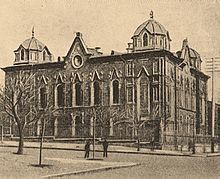Affiliation Orthodox Judaism Architectural style Gothic Florentine Opened 1863 Groundbreaking 1860 | Leadership Rabbi Avraham Wolff Completed 1863 Architectural type Synagogue | |
 | ||
Location Zhukovskoho 18, Odessa, Ukraine | ||
The Brodsky Synagogue in Odessa, was built by the Jews from Brody in 1863 in Odessa, Ukraine. It was the largest synagogue in the South of the then Russian Empire. People came from all over the world to hear cantors sing there.
Contents
Early 1800's
In the early 1800s Jewish immigrants began to stream into Odessa from Europe, many of them came from the town of Brody.
In the 1840s the “Brodsky” Jews leased their first Synagogue, at the corner of Pushkin and Postal (now Zhukovsky) in a relatively small house from the wealthy Greek businessman Ksenysu. The Cantor was Rabbi Nissan Blumenthal, who also came from the town of Brody.
One of the documents from the Office of Novorossiysk and Bessarabian Governor-General, dated from the year 1852, states as follows: "All the educated people of the Jewish community in Odessa are going there. Their school leases a house, but it is deliberately arranged. The hall is quite extensive, there is also a gallery for the women…”
The New Synagogue
In 1860 they received permission to begin building a new synagogue. It was designed by the famous architect Joseph N. Kollovich in the Gothic Florentine style, built with local limestone, and was completed in 1863. It was the largest Synagogue in the south of the then Russian empire.
There were many famous composers and singers who performed in the Synagogue. Among them the composer Novakovsky, and Cantor Minkovsky.
The Synagogue is mentioned in writings of Babel, Shalom-Aleichem, and Ivan Bunin (first Russian writer to win the Nobel Prize for Literature). Ze'ev Jabotinsky, and Meir Dizengoff, former Mayor of Tel Aviv, are among the many Jews associated with this synagogue.
Odessa, Ukraine at one point boasted the second-largest Jewish population (after Warsaw) according to YIVO. In fact, in 1897 Jews in Odessa made up 34.6% of the city’s population.
Synagogue in the Soviet era
In 1920 all the synagogues in Odessa were taken away from the Jewish community. The Brody Synagogue was transformed into the “Rosa Luxemburg Workers Club”, as recorded in YIVO archives, which was a meeting place to push socialist propaganda. The Ten Commandments over the synagogue's alter were covered with a photo of Vladimir Lenin.
During WWII
In 1939 the Jewish population had numbered 180,000, but by 1941 only 54 remained.
During the war, Hitler requested Romanian leader Ion Antonescu to occupy the Ukrainian territory between Dniester and Bug Rivers. In those days, the Odessa State archive was located in the basement of the Uspensky cathedral. The Romanians moved the archive into the “Brodsky” synagogue.
Local and National Landmark
In August 1985, the Odessa Regional Council established the Synagogue as a monument of local importance.
In June 2006, the Ministry of Culture and Tourism of Ukraine included the building in the State Register of Monuments of Ukraine.
Today the building is on the verge of collapse. It has not been renovated for many years. The walls are being held by the bookshelves inside.
Restoration
As of February 2016, the “Brodsky Synagogue” has been returned to the Jewish Community of Odessa. The decision was reached by a decisive majority of the regional council who voted to transfer the building taken from its community nearly 100 years ago.
The building, once restored, will house the Chabad Lubavitch Congregation, and the “Odessa Jewish Museum and Tolerance Center”.
